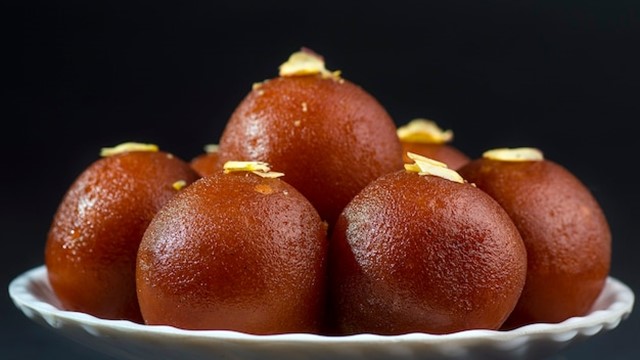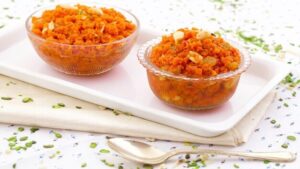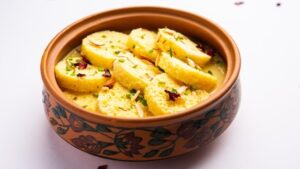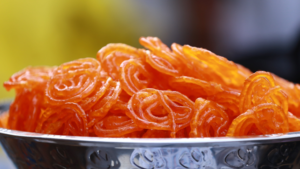Gulab Jamun is a traditional and popular dessert originating from the Indian subcontinent. It is a sweet and indulgent delicacy that consists of soft, spongy dumplings or balls made from a mixture of milk solids, flour, and a leavening agent, typically deep-fried until golden brown.
The term “Gulab Jamun” is derived from Persian words, where ‘Gulab’ translates to “rose” and ‘Jamun’ refers to a type of fruit with a similar size and shape to the dessert. The name signifies both its appearance, resembling small dark berries, and its characteristic soaking in rose-flavored sugar syrup.
Once the golden-fried balls are prepared, they are gently immersed in a fragrant sugar syrup infused with rose water or cardamom. This syrup imparts sweetness and adds a delightful floral aroma to the dessert. Gulab Jamun is often garnished with chopped nuts like almonds, pistachios, or silver leaf, enhancing both its visual appeal and texture.
This dessert holds cultural significance and is commonly served during festivals, celebrations, and special occasions throughout India, symbolizing joy, togetherness, and festivity. It is enjoyed both warm and at room temperature, offering a sumptuous and satisfyingly sweet experience appreciated by dessert enthusiasts worldwide.
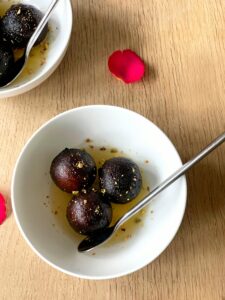
Historical Roots and Culinary Evolution:
Origins from Persia:
Gulab Jamun’s origin can be traced back to Persia, where it was initially known as “Luqmat al-qadi.” Persian invaders introduced this sweet delicacy to the Indian subcontinent centuries ago.Influence in Indian Cuisine:
Over time, this dessert became an integral part of Indian culinary heritage, evolving into what is now known as Gulab Jamun. The dish underwent transformations, adapting to local tastes and ingredients.Evolution of the Recipe:
Originally made using khoya (reduced milk solids), the recipe evolved with the addition of ingredients like flour and baking soda or powder. These variations led to the creation of soft, spongy balls that were deep-fried and immersed in sugar syrup.Cultural Exchange:
The culinary exchange between Persia and India played a pivotal role in the evolution of Gulab Jamun. The Persian influence intertwined with indigenous Indian techniques, resulting in the creation of this beloved dessert, admired for its taste and cultural significance.Symbolism in Name:
The name ‘Gulab Jamun’ emerged from its appearance and the syrup used. ‘Gulab’ refers to ‘rose,’ denoting the rose-flavored syrup used to soak the dessert, while ‘Jamun’ represents a fruit similar in size and shape to the Gulab Jamun balls.
This historical background illustrates the migration and adaptation of a sweet delicacy from Persia to India, its evolution in ingredients and preparation methods, and its eventual establishment as a cherished dessert within Indian culinary traditions. Gulab Jamun’s journey exemplifies cultural exchanges that have enriched the world of food and taste.
Variations and Adaptations:
Variations and adaptations of Gulab Jamun span across different regions and cultures, resulting in diverse renditions of this beloved dessert:
Regional Varieties:

Khoya-based Gulab Jamun: The traditional version employs khoya (reduced milk solids) as the main ingredient. It’s prepared by kneading khoya with a small amount of flour, shaping it into balls, frying, and soaking in sugar syrup.

Paneer-based Gulab Jamun:
In some regions, Gulab Jamun is made using paneer (cottage cheese) instead of khoya. Paneer, combined with a binding agent like maida (all-purpose flour) or semolina, is shaped into balls and treated similarly to khoya-based Jamuns.

Bread Gulab Jamun:
A unique adaptation involves using bread crumbs instead of khoya or paneer. Bread crumbs are moistened with milk, shaped into balls, fried, and then soaked in sugar syrup, resulting in a softer texture.
Flavor and Texture Variations:
- Stuffed Gulab Jamun: Some variations include stuffing the Gulab Jamun balls with nuts like pistachios or almonds, or a mixture of khoya and saffron, enhancing the taste and offering a delightful surprise inside.
- Mini Gulab Jamun: These are smaller-sized Gulab Jamun balls, often served during festivals or parties, providing bite-sized indulgence.
- Fusion Varieties: Modern culinary explorations have led to fusion desserts featuring Gulab Jamun, such as Gulab Jamun cheesecake, ice cream sandwiches, or milkshakes, blending its rich flavors with Western desserts.
Use in Special Occasions:
- Wedding or Festive Varieties: During weddings or festive occasions, special attention is given to Gulab Jamun presentation. It might involve shaping them differently, like elongated cylinders or oval shapes, adding an artistic touch.
- Syrup Variations: Depending on personal preferences or regional tastes, the syrup might be infused with different flavors such as cardamom, saffron, or rose water, offering varied aromatic experiences.
Global Adaptations:
- International Influence: Beyond India, Gulab Jamun has gained popularity worldwide and is often featured in the menus of Indian restaurants globally. Chefs and enthusiasts experiment with adaptations to suit local tastes and ingredients.
The variations and adaptations of Gulab Jamun showcase the culinary creativity and cultural diversity across different regions, allowing for a myriad of delightful experiences while retaining the essence of this iconic Indian dessert.
Cultural Significance:
The cultural significance of Gulab Jamun extends far beyond its delectable taste. Here are the various aspects that highlight its cultural importance:
Festive Symbolism:
- Celebratory Occasions: Gulab Jamun holds a prominent place in festive celebrations, including religious festivals like Diwali, Eid, Holi, and weddings. Its presence symbolizes sweetness, joy, and prosperity during these special occasions.
- Sharing and Togetherness: Sharing Gulab Jamun with friends, family, and neighbors is a gesture of warmth, love, and camaraderie. It fosters a sense of togetherness and strengthens social bonds during gatherings and festivities.
Traditional Offering:
- Offerings in Rituals: In some cultural traditions, Gulab Jamun is offered as Prasad (offering) in temples or during religious ceremonies. Its sweet essence signifies devotion and auspiciousness.
Culinary Heritage:
- Symbol of Culinary Expertise: The preparation of Gulab Jamun demands culinary finesse and tradition. Passing down recipes and techniques from generation to generation preserves culinary heritage and familial traditions.
- Regional Variations: Different regions in India have their versions of Gulab Jamun, showcasing diverse culinary practices and local flavors. These variations reflect the cultural richness and diversity within the country.
Gifting Tradition:
- Gifts and Celebrations: Offering boxes or platters of Gulab Jamun during festivals, weddings, or celebrations is a customary practice. It symbolizes affection, respect, and well-wishing for the recipient.
Embracing Sweetness:
- Symbolism of Sweetness: Gulab Jamun symbolizes the sweetness of life and occasions. Its rich taste and aroma encapsulate the essence of indulgence, happiness, and contentment.
Cultural Integration:
- Global Acceptance: Beyond its Indian origins, Gulab Jamun has transcended cultural boundaries and gained popularity worldwide. It represents India’s rich culinary heritage and is cherished by diverse cultures.
Gulab Jamun’s cultural significance lies not only in its delectable taste but also in its role as a symbol of joy, tradition, sharing, and the sweetness that binds communities together, making it an integral part of India’s cultural tapestry.
Global Popularity
The global popularity of Gulab Jamun has expanded beyond the borders of India, captivating dessert enthusiasts worldwide. Here’s why it has gained international acclaim:
Culinary Diversity:
- Inclusion in Global Menus: Gulab Jamun is featured on the menus of Indian restaurants worldwide, catering to diverse palates and offering a taste of authentic Indian sweets.
- Appreciation of Flavors: Its unique blend of flavors—sweetness from the sugar syrup, aromatic essence from spices like cardamom and rose water, and the rich, spongy texture—resonates with people seeking diverse culinary experiences.
Cultural Representation:
- Embodiment of Indian Cuisine: Gulab Jamun serves as an ambassador of Indian culinary heritage globally, representing the richness and complexity of Indian sweets.
- Symbol of Festivity: When served during cultural festivals or events, Gulab Jamun introduces non-Indian audiences to the festive spirit and celebratory customs prevalent in Indian culture.
Versatile Acceptance:
- Adaptability in Fusion Cuisine: Chefs and food enthusiasts often experiment with Gulab Jamun in fusion desserts, incorporating it into Western-style treats like cakes, ice cream sundaes, or pastries, appealing to varied taste preferences.
- Accommodation of Dietary Preferences: With adaptations accommodating dietary choices, such as vegan or gluten-free versions, Gulab Jamun has become accessible to a broader audience.
Social Media and Culinary Interest:
- Social Media Presence: Its visual appeal and popularity on platforms showcasing global cuisines, culinary blogs, and food vlogs have heightened interest in trying and experiencing this iconic dessert.
- Culinary Curiosity: The exploration of diverse foods and cultures has encouraged individuals to seek out and appreciate Gulab Jamun, fostering a curiosity for traditional Indian sweets.
Gourmet Recognition:
- Fine Dining and Gourmet Treats: Upscale restaurants and gourmet dessert establishments often include Gulab Jamun on their dessert menus, presenting it in elegant presentations that appeal to refined tastes.
Gulab Jamun’s global popularity rests on its unique taste profile, cultural significance, and its ability to transcend cultural barriers, earning recognition and admiration as a delectable dessert that adds a touch of sweetness to global culinary experiences.
Recipe
Here’s a comprehensive recipe to prepare Gulab Jamun, a beloved Indian dessert:
Ingredients:
For the Gulab Jamun:
- 1 cup powdered milk (milk powder)
- 4 tablespoons all-purpose flour (maida)
- 1/4 teaspoon baking soda
- 2 tablespoons ghee (clarified butter), melted
- 3-4 tablespoons milk (approximately)
- Oil or ghee for deep frying
For the Sugar Syrup:
- 2 cups sugar
- 2 cups water
- 4-5 green cardamom pods, lightly crushed
- A few strands of saffron (optional)
- 1 teaspoon rose water
Instructions:
Making the Sugar Syrup:
- Prepare the Syrup: In a saucepan, combine sugar, water, crushed cardamom pods, and saffron. Bring it to a boil over medium heat.
- Simmer the Syrup: Let it simmer for about 8-10 minutes until the sugar dissolves completely and the syrup slightly thickens. Remove from heat and add rose water. Keep it warm for soaking the Gulab Jamuns later.
Making the Gulab Jamun:
- Prepare the Dough: In a mixing bowl, combine powdered milk, all-purpose flour, and baking soda. Add melted ghee and mix well. Gradually add milk, a tablespoon at a time, and knead into a soft, smooth dough. Ensure it’s not too dry or too sticky.
- Shape the Balls: Divide the dough into small portions and roll them into smooth, crack-free balls. Ensure they are uniform in size to ensure even cooking.
- Frying the Gulab Jamun: Heat oil or ghee in a deep pan on low-medium heat. Once the oil is moderately hot, reduce the heat to low. Gently slide the prepared dough balls into the oil. Fry them on low heat, turning them occasionally to ensure even browning. Fry until they turn golden brown.
- Soaking the Gulab Jamun: While the fried balls are still warm, gently immerse them in the warm sugar syrup. Ensure they are entirely submerged in the syrup. Let them soak for at least 1-2 hours to absorb the syrup’s sweetness and flavors.
- Serve Gulab Jamun: Optionally garnish with chopped nuts like pistachios or almonds. Serve warm or at room temperature for a delightful sweet treat.
Enjoy the Soft and Sweet Delight:
Gulab Jamun, with its syrup-soaked texture and aromatic essence, offers a delectable and indulgent experience that’s cherished during festivals, celebrations, or as a sweet treat to savor!

